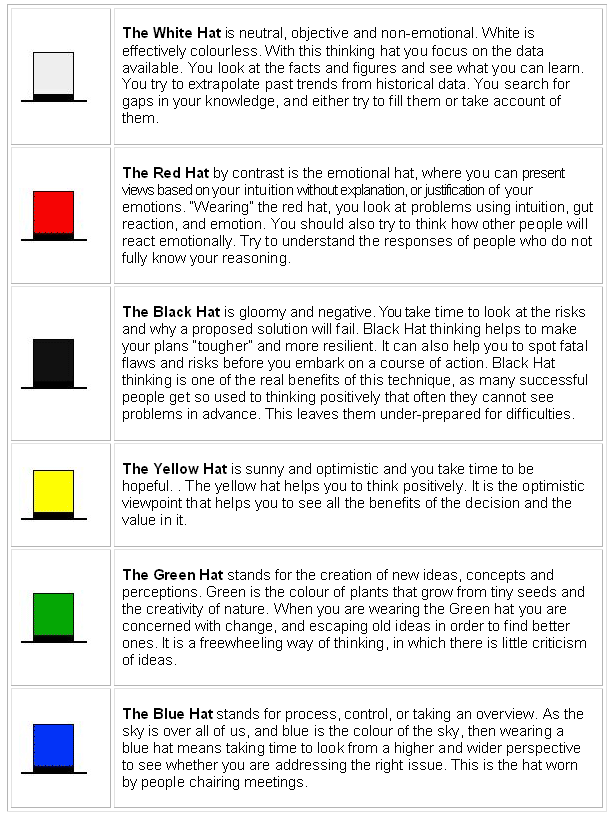 |
| Probably not these ones. |
To provide structure and direction to the wiki, we were given the framework of the De Bono Thinking Hats. For those of you who are unfamiliar with them (I wasn't either, believe it or not), here they are:
By following this framework, we were given a taste of the constructivist learning model, as well as seeing connectivism in action. We were allowed to interpret our reality based on our experiences, and we were also making connections between areas of information through collaboration and networking. The wiki encouraged constructivist learning, because of the way the contributors were encouraged to draw on their own experiences and interpretations. The wiki is also a great example of connectivism at work. It was evident from the outset that one person would not be able to know it all. But in utilizing the "hive-mind" of many students in collaboration and a variety of information sources, a significant volume of knowledge could be collated. The wiki could be made up of contributions from many people, and irrelevant or duplicate information could be edited out. The result was a quite comprehensive document that essentially "wrote the manual
On reflecting on my contribution to the wiki, I was immediately struck by the realization that it was incredibly difficult for me to change hats. I found the black hat the easiest to wear - pointing out the problems and potential issues with the concept, but when I attempted to wear the other hats, they didn't fit very well. I found myself having to stop and think incredibly hard before I contributed to the other colour hats. I also realized that although one person may have a problem with thinking under all the different hats, as a collaborative group there is more chance that all hats will be adequately covered.
I also found it difficult to find original contributions to make to the wiki. A lot of the ideas that I thought of, had already been contributed to the wiki. I didn't want to intentionally duplicate any of the thoughts that had been already added to the wiki, but when reading the other contributions, it was difficult not to be influenced by these thoughts.
I discovered was that some contributions to the wiki followed a train of thought and ended up under the wrong "hat". Some people offered solutions in the "black hat" area, immediately after diagnosing problems. This could be a potential issue in the classroom, but in a wiki we have the ability to filter out duplicates. We can also edit and rearrange the thoughts so that they all make sense and align with the set framework.
Another issue that may arise is that some people may become a little precious about their own contributions to the wiki, and find it hard to give up this autonomy for the greater good of the overall collective of information. In this instance, it may be necessary to make it clear to everyone involved that the information that they contribute no longer belongs to them as individuals, but it now belongs to the group.
I discovered was that some contributions to the wiki followed a train of thought and ended up under the wrong "hat". Some people offered solutions in the "black hat" area, immediately after diagnosing problems. This could be a potential issue in the classroom, but in a wiki we have the ability to filter out duplicates. We can also edit and rearrange the thoughts so that they all make sense and align with the set framework.
Another issue that may arise is that some people may become a little precious about their own contributions to the wiki, and find it hard to give up this autonomy for the greater good of the overall collective of information. In this instance, it may be necessary to make it clear to everyone involved that the information that they contribute no longer belongs to them as individuals, but it now belongs to the group.
Wikis are a safe way of allowing students to contribute to a body of knowledge. They can be set up to be "invitation only", which means that protection of the learners and the teachers can be ensured. It creates a safe learning environment, in which students can be a part of an online community. The structure set in place by the teacher will allow the learners to fully understand the subject, and will provide boundaries to work within. In doing so, the learners will also be given the freedom to respond to the question as they see fit.

That's a great summary of the wiki activity and I agree with your reflections.
ReplyDeleteCheers
Michelle